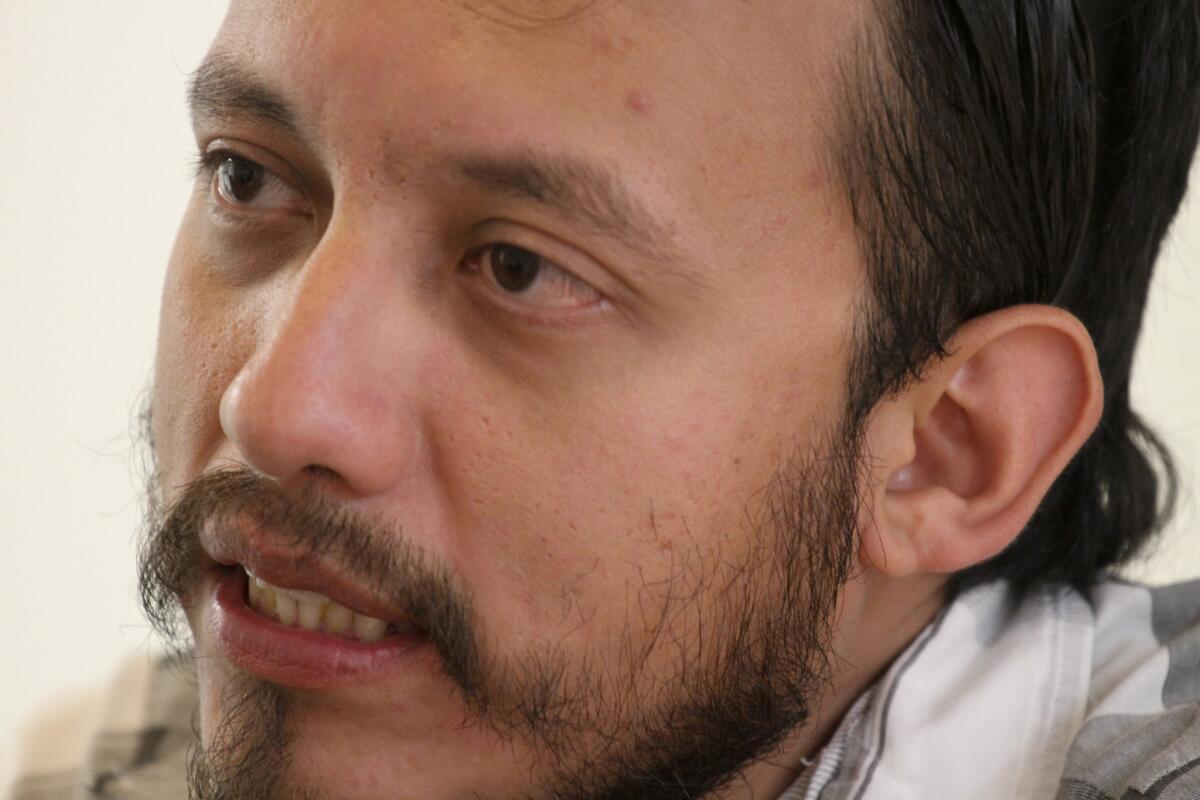For reporters in Mexico, journalist’s death underscores job’s growing danger

In this June 26 photo, Mexican photojournalist Ruben Espinosa speaks during an interview in Mexico City.
Reporting from Mexico City — The young photographer had fled the state of Veracruz in fear for his life to seek security in Mexico City. On Sunday, his fellow journalists mourned the loss of Ruben Espinosa, shot to death two days earlier in a middle-class neighborhood in the capital.
“Killing journalists won’t kill the truth,” read a banner held aloft at a demonstration at the Angel monument in central Mexico City. Some demonstrators held bunches of small white flowers; others worked while they mourned, covering the protest for their publications.
NEWSLETTER: Get the day’s top headlines from Times Editor Davan Maharaj >>
“We’re really surprised that it happened here,” said Sashenka Gutierrez, 35, a Mexican photojournalist who knew Espinosa. “He came here to feel safe.”
But she said the idea that Mexico City could be a haven for journalists fleeing violence in other states had been shattered. Asked what response she expected from Mexican authorities, she shrugged.
“We fear that Ruben’s case will be just another name on the list.”
Espinosa, 31, was the 12th journalist who worked in the state of Veracruz to be killed since 2011. Three more are missing.
Espinosa’s body was found along with those of four women who were also killed late Friday. He had been tied up, his face showed signs of a severe beating. Initial reports said he had been shot twice in the chest. Late Sunday, the attorney general’s office said he had been shot once in the head.
Espinosa, who worked for a number of respected Mexican newsmagazines, including Proceso and Cuarto Oscuro, specialized in covering social movements and was involved in protests seeking justice for the journalists killed in Veracruz. He fled the state on Mexico’s east coast in early June after being harassed, later telling the Mexican political website SinEmbargo that his house had been under surveillance.
The Mexico branch of the international advocacy group Article 19 said that Espinosa’s death marked a new level in violence against journalists in Mexico.
“The threats that Espinosa had suffered were public, and his murder happened because the authorities charged with protecting journalists in this country didn’t lift a finger for him,” said a statement from the group.
The threats against Espinosa started before he fled Veracruz. He described in the SinEmbargo interview how, during a student protest against Veracruz state Gov. Javier Duarte in 2012, a man Espinosa identified as a plainclothes police officer grabbed him by the scruff of the neck. He said the officer told him to stop taking photos unless he wanted to end up like Regina Martinez, a journalist who was killed in her home in Veracruz earlier that year.
Duarte’s administration has been the deadliest for journalists in the history of the state, and the governor has been criticized for his comments about such crimes. During a speech in Veracruz on July 1 he accused some journalists of working for organized crime.
“Behave yourselves, please, I ask of you,” Duarte said to the journalists listening to the speech.
A photojournalist in Veracruz and a friend of Espinosa’s, who didn’t wish to be named for fear of reprisals, told The Times that his friend had asked the government for protection many times.
“It’s practically impossible for us to work now, and the impunity of previous murders have brought us to this point,” the journalist said. “Our work is becoming a death sentence for us.”
No case of a journalist being abducted and killed in Veracruz has been solved, according to Carlos Lauria, the senior program coordinator for the Americas at the Committee to Protect Journalists. He testified before the U.S. Congress last week on the issue of freedom of expression in Mexico.
“The fact that … there is total impunity makes it overwhelming for journalists still doing their jobs and they feel totally vulnerable because they have no guarantees,” he told The Times in a telephone interview.
Saul Ruiz, a Mexican photojournalist who works for the Spanish newspaper El Pais, said, “It doesn’t matter what you cover anymore. You just have to hope that it doesn’t happen to you.”
Veracruz, which is also plagued by drug cartel violence, is among the worst states in a country that is one of the most dangerous in the world for journalists. According to some counts, 88 journalists have been killed in Mexico since 2000 (tallies vary because different organizations use different criteria). Seven journalists have been killed so far this year, and five were killed in 2014.
“This issue is affecting democracy, and the administration of [Mexican President] Enrique Peña Nieto must realize that any other issues on the agenda are going to be impossible to address if this profound, grave crisis is not given the priority it requires,” Lauria said.
Bonello is a special correspondent.
ALSO:
Colombian navy is waging ‘a battle of wits’ with cocaine smugglers
Gang killings of bus workers freezes San Salvador’s transportation system
Drug lord’s prison escape is yet another blow to Mexican president
More to Read
Sign up for Essential California
The most important California stories and recommendations in your inbox every morning.
You may occasionally receive promotional content from the Los Angeles Times.









